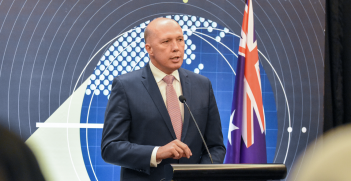Australia and India: Forging a Stronger Relationship

The rise of Asia’s two giants, China and India, is forcing Australia to re-examine an understanding of the regional order that has existed since the end of World War II. There has been much debate about the choices that Australia faces with a rising China, but far less about the consequences of India’s emergence.
A new report by the United States Studies Centre at the University of Sydney, Australia, India and the United States: the challenge of forging new alignments in the Indo- Pacific, looks at the imperatives and challenges faced by Australia in building its strategic relationship with India, and how that relationship might fit with the US alliance.
Developing a security relationship with India presents many challenges. For one thing, India has a strong attachment to the idea of “strategic autonomy”: that India should never need to rely upon other countries. But India’s ideals of going it alone are now being deeply affected by China’s assertive behaviour and its growing presence in the Indian Ocean region. There is a realisation in Delhi that India will need to develop a much closer relationship with Washington (and Canberra and Tokyo). As a result, India-US defence interactions have become increasingly intense, including bilateral exercises, training and transfers of high-end defence technology.
Australia has recognised India as an important strategic partner for more than a decade. Australia’s evolving view of India is intimately linked to its strategic reorientation towards the Indo-Pacific. The idea of an Indo-Pacific strategic arc running from East Asia to West Asia reinforces India’s position as a key regional partner that could eventually rank alongside Australia’s traditional partners. From India’s perspective too, Australia is increasingly recognised as an important partner in building networks across the Indo-Pacific and addressing security concerns in Southeast Asia and the Indian Ocean.
Bilateral defence cooperation
Although security has received a lot of airplay in the relationship, in practice Australia-India defence cooperation remains relatively undeveloped. There are a considerable number of defence and security dialogues between the two countries, but we have only recently begun to see this being translated into more substantive cooperation.
The Indian and Australian navies are the most powerful among the Indian Ocean states and share security responsibilities across this vast ocean. The AUSINDEX naval exercises held in the Bay of Bengal in 2015 were the first substantive bilateral naval exercises between India and Australia for at least 50 years and therefore an important step forward. But we should also be careful to put this in context: the Indian Navy currently conducts exercises or similar operations with at least eight other nations and the Australian Navy conducts bilateral exercises with many countries.
There are many opportunities, including nascent links between the Indian Coast Guard and Australia’s Maritime Border Command, which could become significant. The growing number of shared US-built platforms potentially creates opportunities for cooperation among the two air forces. There are also opportunities for cooperation between special forces which are expected to conduct exercises later this year. However, overall, defence cooperation remains relatively undeveloped and largely still in the realm of the potential.
Building an Australia-US-India partnership in the Indian Ocean
The Forging New Alignments report argues that Australia should promote a trilateral defence and security partnership with India and the United States with a primary focus on the Indian Ocean, the theatre where the interests of the three countries most clearly intersect. The Indian Ocean will likely be the scene of growing strategic instability in coming years, giving Australia a very direct interest in promoting India’s role as a complement to the United States.
Australia, the United States and India have many shared interests in the Indian Ocean. For more than a decade the United States and Australia have both encouraged India to take a more active security role in the Indian Ocean region. Australia will also likely seek to mould India’s aspirations towards regional leadership to take into account the legitimate interests of Australia and other regional states.
Despite caveats and sensitivities in the relationships, there is much that can be achieved among the three countries in the Indian Ocean. Australia should take an incremental and bottom-up approach focusing on the following areas:
Joint exercises: Joint exercises have been the key element of defence cooperation between India and the United States; it is an area that Australia is only just beginning to enter. Australia must continue to press to join the India-US Malabar naval exercises alongside Japan. Australia should also explore opportunities for personnel from the three countries to participate in exercises that may not necessarily be officially trilateral in nature.
Training in northern Australia: Australia should make available its huge training areas in northern Australia for use by India in conjunction with Southeast Asian partners. This would provide excellent opportunities for improving multilateral interoperability between Indo-Pacific partners and further develop Darwin as a hub for regional defence interactions.
Maritime domain awareness: A key area for trilateral cooperation will be in intelligence, surveillance and reconnaissance (ISR) to improve maritime domain awareness. The vastness of distances across the Indian Ocean makes tracking of vessels and aircraft a difficult task which is beyond the resources of any single country. It is a field that India has shown particular interest in cooperating with both the United States and Australia and is an area that holds fewer political sensitivities for India. The recent signing of ‘white shipping‘ (commercial shipping) information-sharing agreements between India and each of Australia and the United States could be steps towards a broader trilateral information-sharing arrangement that could grow to include ‘grey shipping‘ (naval shipping). This could include implicit understandings on areas of primary responsibility for ISR in the Indian Ocean.
Facilities sharing: Information sharing could be bolstered by sharing of facilities. The recent finalisation of the India-US Logistics Exchange Memorandum of Agreement (LEMOA) may ease the way for similar facilities-sharing arrangements between Australia and India. Australia should be open to allowing India to use its facilities on Cocos Island once they have been extended and improved as part of a mutual arrangement in relation to Indian facilities in the Indian Ocean. The United States, India and Australia are all making major investments in ISR capabilities, which will include Boeing P-8 maritime aircraft. The use of common platforms could create important opportunities for cooperation in training, support and maintenance.
MSAR/HADR: Cooperation in maritime search and rescue (MSAR) and humanitarian and disaster relief (HADR) is a politically easy way of promoting greater interaction between armed forces. The Indian Ocean region is particularly susceptible to natural disasters and has few capabilities to deal with them. India, Australia and the United States, along with France, have the strongest capabilities to respond to natural disasters. An ongoing HADR agreement between them would facilitate responses throughout the region and provide practical experience in working together. MSAR is another politically easy way of promoting interaction among armed forces. The experience of the search for Malaysian Airlines flight MH370 demonstrates the growing importance given to responding to these events and the reputational price for failing to take an active role in such activities. Australia, India and France hold primary responsibility for MSAR in large portions of the Indian Ocean. They, together with the United States, have the greatest capabilities in the region and greater cooperation between them will further leverage their abilities.
Over the last decade the US’ and Australia’s defence and security relationships with India have developed on separate but largely parallel paths. Australia needs to bridge this gap by promoting trilateral Australia-India-US cooperation in the Indian Ocean through a bottom-up approach, focusing on specific projects in which the countries can act as equal partners.
Dr David Brewster is a senior research fellow at the National Security College at the Australian National University. He is also distinguished research fellow with the Australia India Institute, University of Melbourne. This article is published under a Creative Commons Licence and may be republished with attribution.





